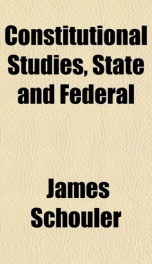constitutional studies state and federal

Purchase of this book includes free trial access to www.million-books.com where you can read more than a million books for free. This is an OCR edition with typos. Excerpt from book: IV. EARLY STATE CONSTITUTIONS. 1776-1789. Let us now consider the main structure of repub- lican government comprised in those separate State instruments which preceded in date our Federal constitution. First and foremost in the design is seen that fundamental threefold division of legislature, executive, and judiciary, as departments which Mon- j tesquieu first of the modern sages announced should j be kept distinct and separated.1 This Montesquieu theorem appears and reappears in our American State constitutions, onward from the Revolutionary period: sometimes concisely stated as in Virginia's Bill of Rights,2 and again couched in the stately and resonant expression of the Massachusetts constitution.3 But most political dogmas are of imperfect application; 1 "The celebrated Montesquieu is the oracle always consulted and cited on this subject." Federalist, No. 47. Yet Aristotle in his "Politics," centuries earlier, distinctly defined the three appropriate departments of a Republic as the deliberative, executive, and judicial, a description imperfect only because legislation in a representative instead of collective assembly (which is a modern contrivance) had not then been invented. 2 Virginia Declaration, 1776 (No. 5); somewhat amplified, however, in the Virginia constitution. 8 "The legislative department shall never exercise the executive and judicial powers, or either of them; the executive shall never exercise the legislative and judicial powers, or either of them; the judicial shall never exercise the legislative and executive powers, or either of them; to the end it may be a government of laws and not of men." Massachusetts Declaration of 1780 (No. 30). and the practice of American government has constantly been to so far connect and blend these separa...
Info about the book
Author:
Series:
Unknown
ASIN:
052112560X
Rating:
3/5 (4)Your rating:
0/5
Languge:
English
Users who have this book
Users who want this book
What readers are saying
What do you think? Write your own comment on this book!
write a commentGenre
if you like constitutional studies state and federal try:
Other books by this author
Do you want to exchange books? It’s EASY!
Get registered and find other users who want to give their favourite books to good hands!


